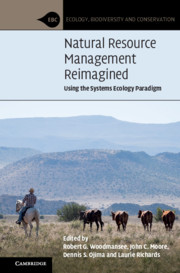Book contents
- Natural Resource Management Reimagined
- Ecology, Biodiversity and Conservation
- Natural Resource Management Reimagined
- Copyright page
- Contents
- Contributors
- Preface
- 1 The Systems Ecology Paradigm
- 2 Environmental and Natural Resource Challenges in the Twenty-First Century
- 3 Evolution of Ecosystem Science to Advance Science and Society in the Twenty-First Century
- 4 Five Decades of Modeling Supporting the Systems Ecology Paradigm
- 5 Advances in Technology Supporting the Systems Ecology Paradigm
- 6 Emergence of Cross-Scale Structural and Functional Processes in Ecosystem Science
- 7 Evolution of the Systems Ecology Paradigm in Managing Ecosystems
- 8 Land/Atmosphere/Water Interactions
- 9 Humans in Ecosystems
- 10 A Systems Ecology Approach for Community-Based Decision Making
- 11 Environmental Literacy
- 12 Organizational and Administrative Challenges and Innovations
- 13 Where to From Here? Unraveling Wicked Problems
- Index
- References
8 - Land/Atmosphere/Water Interactions
Published online by Cambridge University Press: 25 February 2021
- Natural Resource Management Reimagined
- Ecology, Biodiversity and Conservation
- Natural Resource Management Reimagined
- Copyright page
- Contents
- Contributors
- Preface
- 1 The Systems Ecology Paradigm
- 2 Environmental and Natural Resource Challenges in the Twenty-First Century
- 3 Evolution of Ecosystem Science to Advance Science and Society in the Twenty-First Century
- 4 Five Decades of Modeling Supporting the Systems Ecology Paradigm
- 5 Advances in Technology Supporting the Systems Ecology Paradigm
- 6 Emergence of Cross-Scale Structural and Functional Processes in Ecosystem Science
- 7 Evolution of the Systems Ecology Paradigm in Managing Ecosystems
- 8 Land/Atmosphere/Water Interactions
- 9 Humans in Ecosystems
- 10 A Systems Ecology Approach for Community-Based Decision Making
- 11 Environmental Literacy
- 12 Organizational and Administrative Challenges and Innovations
- 13 Where to From Here? Unraveling Wicked Problems
- Index
- References
Summary
Emerging from the warehouse of knowledge about terrestrial ecosystem functioning and the application of the systems ecology paradigm, exemplified by the power of simulation modeling, tremendous strides have been made linking the interactions of the land, atmosphere, and water locally to globally. Through integration of ecosystem, atmospheric, soil, and more recently social science interactions, plausible scenarios and even reasonable predictions are now possible about the outcomes of human activities. The applications of that knowledge to the effects of changing climates, human-caused nitrogen enrichment of ecosystems, and altered UV-B radiation represent challenges addressed in this chapter. The primary linkages addressed are through the C, N, S, and H2O cycles, and UV-B radiation. Carbon dioxide exchanges between land and the atmosphere, N additions and losses to and from lands and waters, early studies of SO2 in grassland ecosystem, and the effects of UV-B radiation on ecosystems have been mainstays of research described in this chapter. This research knowledge has been used in international and national climate assessments, for example the IPCC, US National Climate Assessment, and Paris Climate Accord. Likewise, the knowledge has been used to develop concepts and technologies related to sustainable agriculture, C sequestration, and food security.
Keywords
- Type
- Chapter
- Information
- Natural Resource Management ReimaginedUsing the Systems Ecology Paradigm, pp. 245 - 278Publisher: Cambridge University PressPrint publication year: 2021



